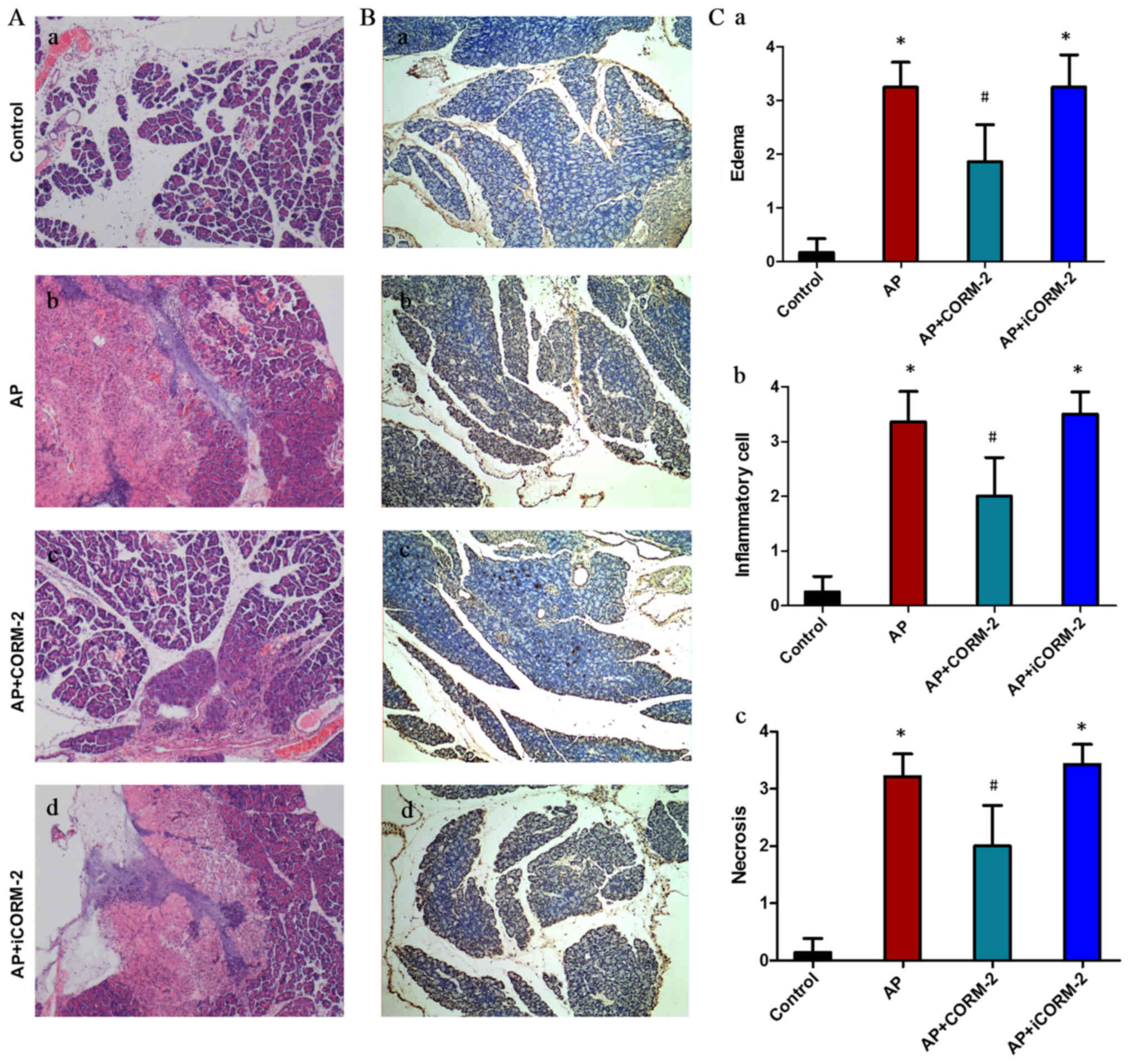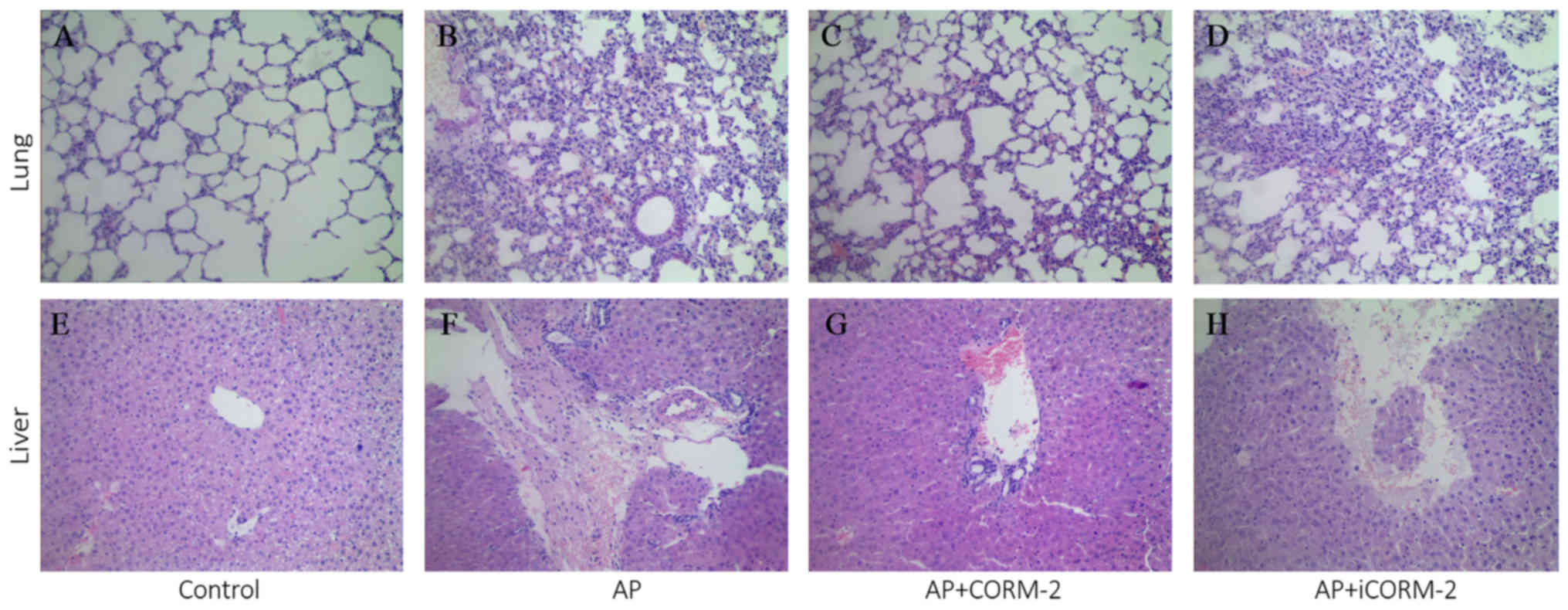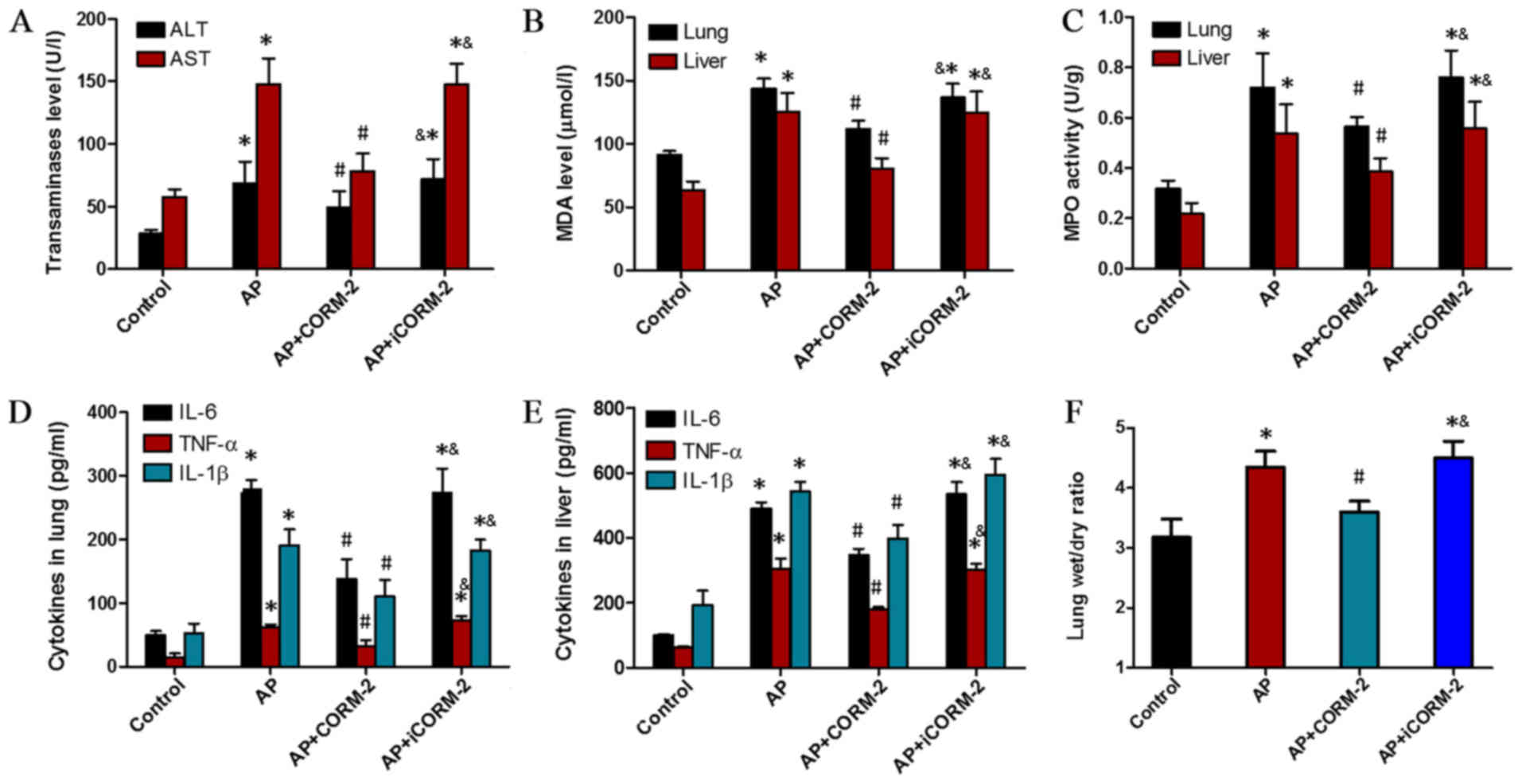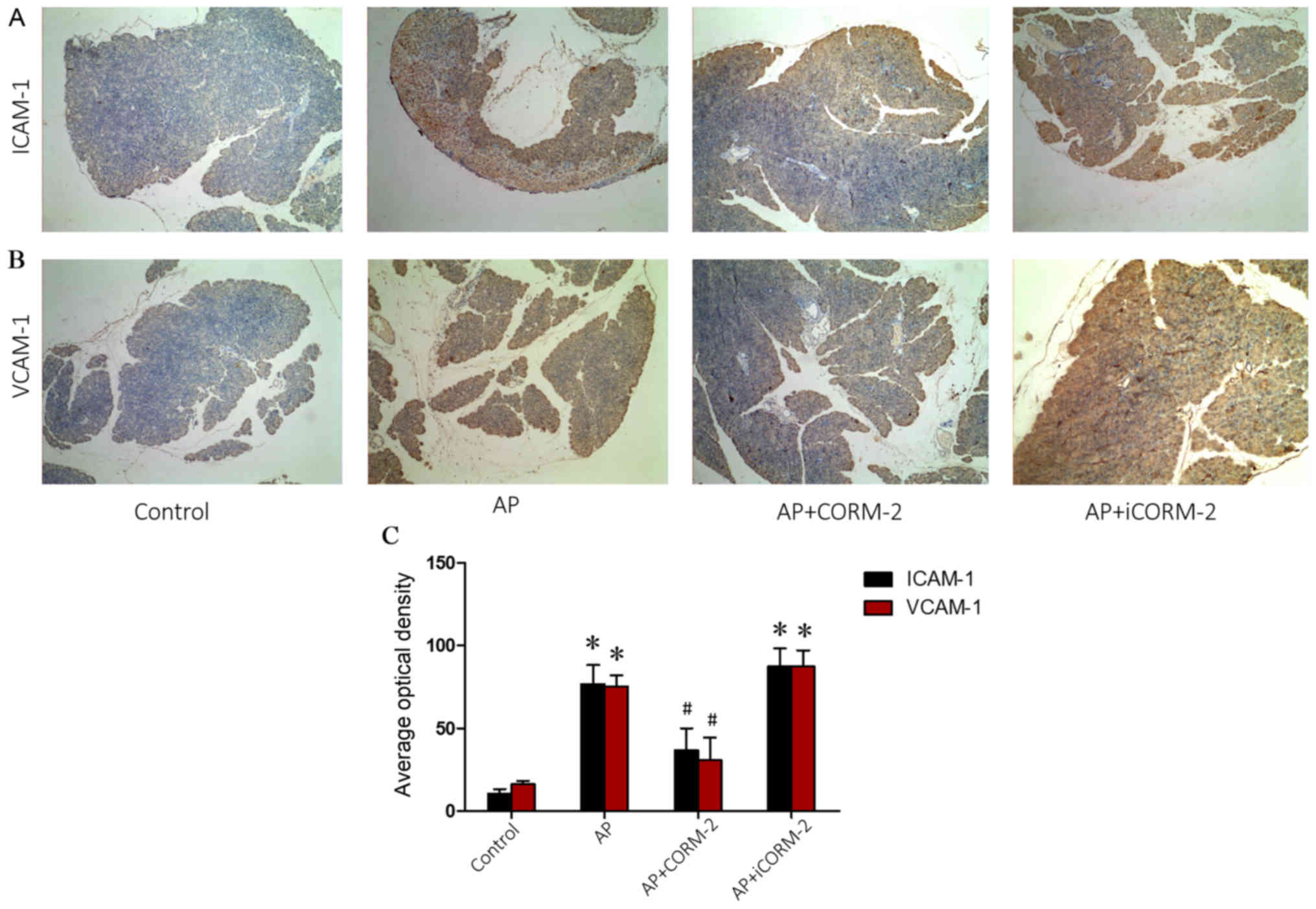|
1
|
Yadav D and Lowenfels AB: Trends in the
epidemiology of the first attack of acute pancreatitis: A
systematic review. Pancreas. 33:323–330. 2006. View Article : Google Scholar : PubMed/NCBI
|
|
2
|
Ohashi S, Nishio A, Nakamura H, Kido M,
Ueno S, Uza N, Inoue S, Kitamura H, Kiriya K, Asada M, et al:
Protective roles of redox-active protein thioredoxin-1 for severe
acute pancreatitis. Am J Physiol Gastrointest Liver Physiol.
290:G772–G781. 2006. View Article : Google Scholar : PubMed/NCBI
|
|
3
|
Bhatia M, Ramnath RD, Chevali L and
Guglielmotti A: Treatment with bindarit, a blocker of MCP-1
synthesis, protects mice against acute pancreatitis. Am J Physiol
Gastrointest Liver Physiol. 288:G1259–G1265. 2005. View Article : Google Scholar : PubMed/NCBI
|
|
4
|
Cuzzocrea S, Genovese T, Mazzon E, Di
Paola R, Muià C, Britti D and Salvemini D: Reduction in the
development of cerulein-induced acute pancreatitis by treatment
with M40401, a new selective superoxide dismutase mimetic. Shock.
22:254–261. 2004. View Article : Google Scholar : PubMed/NCBI
|
|
5
|
Escobar J, Pereda J, Arduini A, Sandoval
J, Sabater L, Aparisi L, López-Rodas G and Sastre J: Cross-talk
between oxidative stress and pro-inflammatory cytokines in acute
pancreatitis: A key role for protein phosphatases. Curr Pharm Des.
15:3027–3042. 2009. View Article : Google Scholar : PubMed/NCBI
|
|
6
|
Zhou HX, Han B, Hou LM, An TT, Jia G,
Cheng ZX, Ma Y, Zhou YN, Kong R, Wang SJ, et al: Protective effects
of hydrogen gas on experimental acute pancreatitis. PLoS One.
11:e01544832016. View Article : Google Scholar : PubMed/NCBI
|
|
7
|
Pereda J, Escobar J, Sandoval J, Rodríguez
JL, Sabater L, Pallardó FV, Torres L, Franco L, Viña J, López-Rodas
G and Sastre J: Glutamate cysteine ligase up-regulation fails in
necrotizing pancreatitis. Free Radic Biol Med. 44:1599–1609. 2008.
View Article : Google Scholar : PubMed/NCBI
|
|
8
|
Gómez-Cambronero LG, Sabater L, Pereda J,
Cassinello N, Camps B, Viña J and Sastre J: Role of cytokines and
oxidative stress in the pathophysiology of acute pancreatitis:
therapeutical implications. Curr Drug Targets Inflamm Allergy.
1:393–403. 2002. View Article : Google Scholar : PubMed/NCBI
|
|
9
|
Altavilla D, Famulari C, Passaniti M,
Galeano M, Macrì A, Seminara P, Minutoli L, Marini H, Calò M,
Venuti FS, et al: Attenuated cerulein-induced pancreatitis in
nuclear factor-kappaB-deficient mice. Lab Invest. 83:1723–1732.
2003. View Article : Google Scholar : PubMed/NCBI
|
|
10
|
Yu JH, Lim JW, Namkung W, Kim H and Kim
KH: Suppression of cerulein-induced cytokine expression by
antioxidants in pancreatic acinar cells. Lab Invest. 82:1359–1368.
2002. View Article : Google Scholar : PubMed/NCBI
|
|
11
|
Pereda J, Sabater L, Aparisi L, Escobar J,
Sandoval J, Viña J, López-Rodas G and Sastre J: Interaction between
cytokines and oxidative stress in acute pancreatitis. Curr Med
Chem. 13:2775–2787. 2006. View Article : Google Scholar : PubMed/NCBI
|
|
12
|
Frossard JL, Hadengue A, Spahr L, Morel P
and Pastor CM: Natural history of long-term lung injury in mouse
experimental pancreatitis. Crit Care Med. 30:1541–1546. 2002.
View Article : Google Scholar : PubMed/NCBI
|
|
13
|
Bak I, Szendrei L, Turoczi T, Papp G, Joo
F, Das DK, de Leiris J, Der P, Juhasz B, Varga E, et al: Heme
oxygenase-1-related carbon monoxide production and ventricular
fibrillation in isolated ischemic/reperfused mouse myocardium.
FASEB J. 17:2133–2135. 2003. View Article : Google Scholar : PubMed/NCBI
|
|
14
|
Song H, Zhao H, Qu Y, Sun Q, Zhang F, Du
Z, Liang W, Qi Y and Yang P: Carbon monoxide releasing molecule-3
inhibits concurrent tumor necrosis factor-α- and
interleukin-1β-induced expression of adhesion molecules on human
gingival fibroblasts. J Periodontal Res. 46:48–57. 2011. View Article : Google Scholar : PubMed/NCBI
|
|
15
|
Patterson EK, Fraser DD, Capretta A,
Potter RF and Cepinskas G: Carbon monoxide-releasing molecule 3
inhibits myeloperoxidase (MPO) and protects against MPO-induced
vascular endothelial cell activation/dysfunction. Free Radic Biol
Med. 70:167–173. 2014. View Article : Google Scholar : PubMed/NCBI
|
|
16
|
Zheng M, Zhang Q, Joe Y, Kim SK, Uddin MJ,
Rhew H, Kim T, Ryter SW and Chung HT: Carbon monoxide-releasing
molecules reverse leptin resistance induced by endoplasmic
reticulum stress. Am J Physiol Endocrinol Metab. 304:E780–E788.
2013. View Article : Google Scholar : PubMed/NCBI
|
|
17
|
Lee TS and Chau LY: Heme oxygenase-1
mediates the anti-inflammatory effect of interleukin-10 in mice.
Nat Med. 8:240–246. 2002. View Article : Google Scholar : PubMed/NCBI
|
|
18
|
Motterlini R, Mann BE, Johnson TR, Clark
JE, Foresti R and Green CJ: Bioactivity and pharmacological actions
of carbon monoxide-releasing molecules. Curr Pharm Des.
9:2525–2539. 2003. View Article : Google Scholar : PubMed/NCBI
|
|
19
|
Seixas JD, Santos MF, Mukhopadhyay A,
Coelho AC, Reis PM, Veiros LF, Marques AR, Penacho N, Gonçalves AM,
Romão MJ, et al: A contribution to the rational design of
Ru(CO)3Cl2L complexes for in vivo delivery of CO. Dalton Trans.
44:5058–5075. 2015. View Article : Google Scholar : PubMed/NCBI
|
|
20
|
Motterlini R, Clark JE, Foresti R,
Sarathchandra P, Mann BE and Green CJ: Carbon monoxide-releasing
molecules: Characterization of biochemical and vascular activities.
Circ Res. 90:E17–E24. 2002. View Article : Google Scholar : PubMed/NCBI
|
|
21
|
Chung SW, Liu X, Macias AA, Baron RM and
Perrella MA: Heme oxygenase-1-derived carbon monoxide enhances the
host defense response to microbial sepsis in mice. J Clin Invest.
118:239–247. 2008. View Article : Google Scholar : PubMed/NCBI
|
|
22
|
Sun B, Sun Z, Jin Q and Chen X:
CO-releasing molecules (CORM-2)-liberated CO attenuates leukocytes
infiltration in the renal tissue of thermally injured mice. Int J
Biol Sci. 4:176–183. 2008. View Article : Google Scholar : PubMed/NCBI
|
|
23
|
Lee S, Lee SJ, Coronata AA, Fredenburgh
LE, Chung SW, Perrella MA, Nakahira K, Ryter SW and Choi AM: Carbon
monoxide confers protection in sepsis by enhancing beclin
1-dependent autophagy and phagocytosis. Antioxid Redox Signal.
20:432–442. 2014. View Article : Google Scholar : PubMed/NCBI
|
|
24
|
Wang X, Qin W, Qiu X, Cao J, Liu D and Sun
B: A novel role of exogenous carbon monoxide on protecting cardiac
function and improving survival against sepsis via mitochondrial
energetic metabolism pathway. Int J Biol Sci. 10:777–788. 2014.
View Article : Google Scholar : PubMed/NCBI
|
|
25
|
Pastor CM, Pugin J, Kwak B, Chanson M,
Mach F, Hadengue A and Frossard JL: Role of Toll-like receptor 4 on
pancreatic and pulmonary injury in a mice model of acute
pancreatitis associated with endotoxemia. Crit Care Med.
32:1759–1763. 2004. View Article : Google Scholar : PubMed/NCBI
|
|
26
|
Bhatia M, Slavin J, Cao Y, Basbaum AI and
Neoptolemos JP: Preprotachykinin-a gene deletion protects mice
against acute pancreatitis and associated lung injury. Am J Physiol
Gastrointest Liver Physiol. 284:G830–G836. 2003. View Article : Google Scholar : PubMed/NCBI
|
|
27
|
Sharif R, Dawra R, Wasiluk K, Phillips P,
Dudeja V, Kurt-Jones E, Finberg R and Saluja A: Impact of toll-like
receptor 4 on the severity of acute pancreatitis and
pancreatitis-associated lung injury in mice. Gut. 58:813–819. 2009.
View Article : Google Scholar : PubMed/NCBI
|
|
28
|
Shen WC, Wang X, Qin WT, Qiu XF and Sun
BW: Exogenous carbon monoxide suppresses Escherichia coli vitality
and improves survival in an Escherichia coli-induced murine sepsis
model. Acta Pharmacol Sin. 35:1566–1576. 2014. View Article : Google Scholar : PubMed/NCBI
|
|
29
|
Liu DM, Sun BW, Sun ZW, Jin Q, Sun Y and
Chen X: Suppression of inflammatory cytokine production and
oxidative stress by CO-releasing molecules-liberated CO in the
small intestine of thermally-injured mice. Acta Pharmacol Sin.
29:838–846. 2008. View Article : Google Scholar : PubMed/NCBI
|
|
30
|
Sun BW, Jin Q, Sun Y, Sun ZW, Chen X, Chen
ZY and Cepinskas G: Carbon liberated from CO-releasing molecules
attenuates leukocyte infiltration in the small intestine of
thermally injured mice. World J Gastroenterol. 13:6183–6190. 2007.
View Article : Google Scholar : PubMed/NCBI
|
|
31
|
Deng W, Hui Y, Yu J, Wang W, Xu S, Chen C
and Xiong X: A new pathological scoring method for adrenal injury
in rats with severe acute pancreatitis. Pathol Res Pract.
210:1011–1017. 2014. View Article : Google Scholar : PubMed/NCBI
|
|
32
|
Barker PM, Nguyen MS, Gatzy JT, Grubb B,
Norman H, Hummler E, Rossier B, Boucher RC and Koller B: Role of
gammaENaC subunit in lung liquid clearance and electrolyte balance
in newborn mice. Insights into perinatal adaptation and
pseudohypoaldosteronism. J Clin Invest. 102:1634–1640. 1998.
View Article : Google Scholar : PubMed/NCBI
|
|
33
|
Hillegass LM, Griswold DE, Brickson B and
Albrightson-Winslow C: Assessment of myeloperoxidase activity in
whole rat kidney. J Pharmacol Methods. 24:285–295. 1990. View Article : Google Scholar : PubMed/NCBI
|
|
34
|
Wang J, Chen G, Gong H, Huang W, Long D
and Tang W: Amelioration of experimental acute pancreatitis with
dachengqi decoction via regulation of necrosis-apoptosis switch in
the pancreatic acinar cell. PLoS One. 7:e401602012. View Article : Google Scholar : PubMed/NCBI
|
|
35
|
Bang S, Kang YH, Reynolds C and Kang M:
The pan-Bcl-2 family inhibitor ABT-737 synergizes with DNA damaging
agents by enhancing apoptosis in acute lymphoblastic leukemia
cells. Cancer Research. 69:2009.
|
|
36
|
Funaro A, Ortolan E, Ferranti B, Gargiulo
L, Notaro R, Luzzatto L and Malavasi F: CD157 is an important
mediator of neutrophil adhesion and migration. Blood.
104:4269–4278. 2004. View Article : Google Scholar : PubMed/NCBI
|
|
37
|
Dawra R, Ku YS, Sharif R, Dhaulakhandi D,
Phillips P, Dudeja V and Saluja AK: An improved method for
extracting myeloperoxidase and determining its activity in the
pancreas and lungs during pancreatitis. Pancreas. 37:62–68. 2008.
View Article : Google Scholar : PubMed/NCBI
|
|
38
|
Armbruster C and Kriwanek S: Multicentre
audit of death from acute pancreatitis. Br J Surg. 81:16971994.
View Article : Google Scholar : PubMed/NCBI
|
|
39
|
Chen P, Sun B, Chen H, Wang G, Pan S, Kong
R, Bai X and Wang S: Effects of carbon monoxide releasing
molecule-liberated CO on severe acute pancreatitis in rats.
Cytokine. 49:15–23. 2010. View Article : Google Scholar : PubMed/NCBI
|
|
40
|
Rae D, Bowyer RC and Wharton RQ:
Inflammatory mediators in acute pancreatitis. Br J Surg.
82:8551995. View Article : Google Scholar : PubMed/NCBI
|
|
41
|
de Beaux AC, Goldie AS, Ross JA, Carter DC
and Fearon KC: Serum concentrations of inflammatory mediators
related to organ failure in patients with acute pancreatitis. Br J
Surg. 83:349–353. 1996. View Article : Google Scholar : PubMed/NCBI
|
|
42
|
Wang X, Qin W, Song M, Zhang Y and Sun B:
Exogenous carbon monoxide inhibits neutrophil infiltration in
LPS-induced sepsis by interfering with FPR1 via p38 MAPK but not
GRK2. Oncotarget. 7:34250–34265. 2016.PubMed/NCBI
|
|
43
|
Sun BW, Zhang P, Zou XQ, Shi GS and Sun Y:
Inhibitive effect of exogenous carbon monoxide-releasing molecules
2 on the activation of Janus kinase/signal transducer and activator
of transcription pathway in sepsis. Zhonghua Shao Shang Za Zhi.
26:100–103. 2010.(In Chinese). PubMed/NCBI
|
|
44
|
Sun BW, Shi GS, Zhang P, Zou XQ and Chen
X: Inhibitive effect of exogenous carbon monoxide-releasing
molecules 2 on tissue factor expression in sepsis. Zhonghua Shao
Shang Za Zhi. 25:111–114. 2009.(In Chinese). PubMed/NCBI
|
|
45
|
Xue J and Habtezion A: Carbon
monoxide-based therapy ameliorates acute pancreatitis via TLR4
inhibition. J Clin Invest. 124:437–447. 2014. View Article : Google Scholar : PubMed/NCBI
|
|
46
|
Kim GY, Roh SI, Park SK, Ahn SC, Oh YH,
Lee JD and Park YM: Alleviation of experimental septic shock in
mice by acidic polysaccharide isolated from the medicinal mushroom
Phellinus linteus. Biol Pharm Bull. 26:1418–1423. 2003.
View Article : Google Scholar : PubMed/NCBI
|
|
47
|
Bettaieb A, Chahed S, Tabet G, Yang J,
Morisseau C, Griffey S, Hammock BD and Haj FG: Effects of soluble
epoxide hydrolase deficiency on acute pancreatitis in mice. PLoS
One. 9:e1130192014. View Article : Google Scholar : PubMed/NCBI
|
|
48
|
Yin MJ, Yamamoto Y and Gaynor RB: The
anti-inflammatory agents aspirin and salicylate inhibit the
activity of I(kappa)B kinase-beta. Nature. 396:77–80. 1998.
View Article : Google Scholar : PubMed/NCBI
|
|
49
|
Sun B, Zou X, Chen Y, Zhang P and Shi G:
Preconditioning of carbon monoxide releasing molecule-derived CO
attenuates LPS-induced activation of HUVEC. Int J Biol Sci.
4:270–278. 2008. View Article : Google Scholar : PubMed/NCBI
|
|
50
|
Dolinay T, Szilasi M, Liu M and Choi AM:
Inhaled carbon monoxide confers antiinflammatory effects against
ventilator-induced lung injury. Am J Respir Crit Care Med.
170:613–620. 2004. View Article : Google Scholar : PubMed/NCBI
|
|
51
|
Motterlini R and Otterbein LE: The
therapeutic potential of carbon monoxide. Nat Rev Drug Discov.
9:728–743. 2010. View Article : Google Scholar : PubMed/NCBI
|
|
52
|
Tzeng E: Carbon monoxide: Vascular
therapeutic for the future. Vascular. 17 (Suppl 1):S55–S62. 2009.
View Article : Google Scholar : PubMed/NCBI
|
|
53
|
Thom SR, Weaver LK and Hampson NB:
Therapeutic carbon monoxide may be toxic. Am J Respir Crit Care
Med. 171:13182005. View Article : Google Scholar : PubMed/NCBI
|
|
54
|
Desmard M, Foresti R, Morin D, Dagouassat
M, Berdeaux A, Denamur E, Crook SH, Mann BE, Scapens D, Montravers
P, et al: Differential antibacterial activity against Pseudomonas
aeruginosa by carbon monoxide-releasing molecules. Antioxid Redox
Signal. 16:53–63. 2012. View Article : Google Scholar
|






















